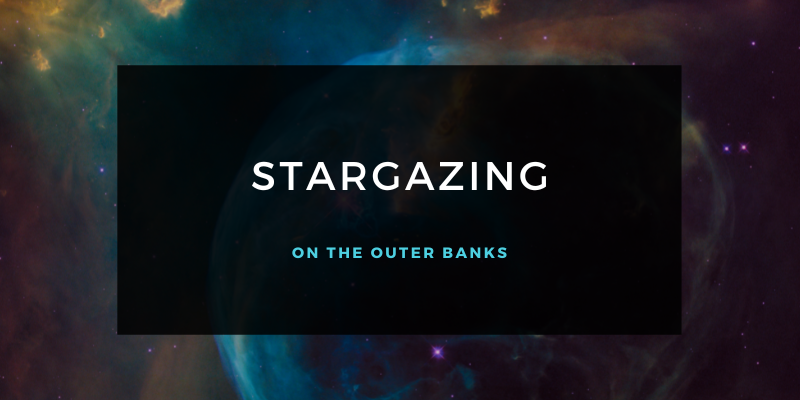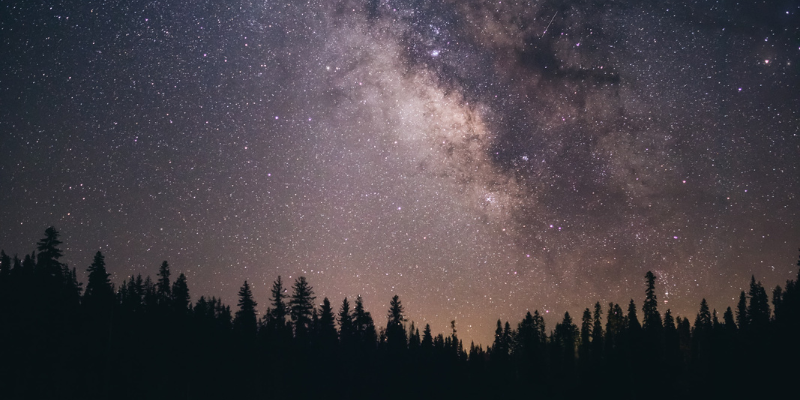Clear Nights and Starlight: Outer Banks Stargazing
Imagine a place devoid of artificial light pollution, with wide open expanses of shoreline and sky that are perfect for watching meteor showers and shooting stars, tracing the movements of the constellations, and taking in the breathtaking landscape of twinkling stars in the night sky.
You'd be correct if you pictured the Outer Banks of North Carolina!
The Cape Hatteras National Seashore has been nominated as one of the best locations in the world to catch a glimpse of the Milky Way and both Ocracoke and Duck have been listed as some of the best places to stargaze in North Carolina. Keep reading below for more information and suggestions for the best way to enjoy stargazing during your next Outer Banks vacation!
Where is the Best Spot on the OBX for Stargazing?
Carova
If you’ve got an Off-Road Vehicle Permit for the Currituck Beaches, one of the best places to go for stargazing with minimal light inference will be the beaches of the 4x4 area in Carova. There’s plenty of shoreline with spectacular views of the ocean, the chance to see wildlife at night, and plenty of open skies that should provide you with the ultimate viewing experience. Check out our OBX Beach Driving Guide for more information about permits and driving on the beaches. Please note that the Carova driving lanes shift in the evening, so plan your stargazing adventure accordingly.
Duck
If you’re staying in Duck and have access to the beach, Duck is regarded as one of the best areas in the northeastern part of the state for spotting constellations in the North Carolina Sky. Because of its secluded location between the sound and the ocean, you’ll be able to see plenty of objects in the sky, as long as the moon doesn’t interfere.
Bodie Island Lighthouse
According to folks on Tripadvisor, the Bodie Island Lighthouse and the surrounding beaches are a fantastic place to go at night for some ideal star spotting! The lighthouse is fun to explore during the daytime, but at night, the lack of light pollution due to its secluded location makes it a fantastic place to simply look up and see the stars!
Cape Hatteras National Seashore
The beaches near Avon, Frisco, and Salvo are often regarded as some of the best places to watch the stars without extra light pollution. Take a stroll down to the beach from your beach house and be sure to look up and enjoy the beauty of the night sky over the ocean. From the beaches of Cape Hatteras, catching a glimpse of the Milky Way will be easy and exciting for the whole family!
Ocracoke
Ocracoke Island has been regarded as one of the darkest places in the country due to the lack of light pollution. This is the perfect place to get a view of the Milky Way without lights from towns or stores interfering.
Things to Look For
In addition to constellations, the moon, and shooting stars, there are some very specific interstellar objects to be on the lookout for that will make your stargazing journey a once-in-a-lifetime adventure!
Meteor Showers
Check out the Meteor Shower Calendar to see when meteor showers are going to peak on the Outer Banks! The Perseids meteor shower is the most reliable one that usually peaks in the middle of August every year.
Rocket Launch
While you may not necessarily be able to see a rocket launch every time that you’re here, the Outer Banks is relatively close to Wallops Island Flight Facility in Virginia, meaning that, on a clear night, you can spend some of your stargazing time watching NASA shoot a rocket into outer space! You can find the Wallops Flight Facility launch schedule here.
Planets
Throughout the year, up to seven planets can be seen in the Outer Banks night sky at any time! These objects will often look like extra bright stars, but if you do have a telescope, bring it with you and try to see some detail! Check here for specific planet-rising times during your stay!
Can You See the Milky Way from the Outer Banks?
Yes! The Milky Way is visible year-round from the Outer Banks and it can be seen with the naked eye! Look for a cluster of stars that appear to make a line. This will be the core of the Milky Way and is best seen from the beginning of March to the end of October.
When is the Best Time for Stargazing on the Outer Banks?
Generally speaking, any time on the Outer Banks is great for stargazing! But if you're looking to view some specific objects, there are a few things you'll want to consider.
- The best time to see the Milky Way is from early March to late October, between Midnight and 5AM.
- The best time to see planets is November, when up to 7 planets can be seen clearly ata one time.
- The best time to see the annual Perseids Meteor Shower is around mid-August.
- Similiarly, during the summer and the fall, full moon climbs are available at the Bodie Island Lighthouse, meaning that you can catch a glimpe of the summer sky from a different angle.
- It's best to stargaze when there is a new, crescent, or gibbous Moon, to eliminate as much light pollution from the moon itself as possible.
More Tips and Advice for Spectacular Outer Banks Stargazing
While it may seem intuitive, effective stargazing is actually more of an art form that requires a little bit of pre-planning to get the most out of your trip. Of course, you can always just step out onto the porch of your cozy beach cottage or lay a blanket out on the sand, but here are some tips and suggestions if you’re looking to experience the ultimate stargazing adventure.
Get Familiar with the Constellations and Their Location
While there won’t be a huge amount of difference if you’re visiting from anywhere within the United States, your stargazing adventures are guaranteed to be more effective if you have a good idea of what you’re supposed to be seeing from your current location. Many of us still remember learning the constellations in school, but if you want to get a little more detail about the sky above you, why not try using a sky chart?
Sky & Telescope magazine offers an online Interactive Sky Chart that is perfect for figuring out the best things to look for in the night sky! All you have to do is enter your zip code, city, or latitude/longitude to get a detailed map of what you should be able to see in the sky above you once you’ve settled in on your deck or gotten set up on the sand. The chart is also mobile-friendly, so it’s easy to take it out with you wherever you’re planning to explore.
Download the Apps
Speaking of cell phones, stargazing with your smartphone or tablet has never been easier! With advances in technology and the benefits of satellites and location trackers, there are plenty of options for apps to download on your smartphone that will help you find and name exactly what it is you’re looking at in real-time! Stellarium Mobile Free or Stellarium Plus give users an “augmented reality experience” based on your location that overlays your current night sky with stars, constellations, planets, and comets. According to Sky at Night magazine, other wonderful options for apps include: SkySafari, Star Tracker, Mobile Observatory Free, and Heavens-Above.
Check the weather, moon phases, etc.
Depending on the time of year that you’re planning to go stargazing, it’s important to keep an eye on the weather, as well as the phases of the moon and shifting constellations. While there are often plenty of clear, night skies on the Outer Banks that are perfect for catching a glimpse of your favorite constellations, it’s important to keep an eye on the ever-changing weather forecasts that the Outer Banks is known for. Storms can unexpectedly pop up, especially during the summer months, so be sure to plan ahead. Additionally, while viewing the moon can also be a fun and rewarding stargazing experience, if you’re hoping to spot a particular star or a meteor shower, plan for the extra light that a full moon will give and adjust your expectations accordingly. Try to plan your stargazing adventure during a new moon for the ultimate dark-sky experience.
Let Your Eyes Adapt to the Darkness
Before you start searching in the sky above, be sure to give yourself plenty of time to let your eyes adjust to the darkness. It can take anywhere upwards of 20 minutes for your eyes to adjust to the dark but don’t rush it. Enjoy the sights and sounds of the beach or patio where you’re stargazing and simply let yourself relax into the peace of the darkness. Once you’ve spent the time letting your pupils dilate, you’ll be much more adapted to finding what you’re looking for overhead.
Include the Whole Family
Since you don’t really need any fancy equipment, besides your own eyes and maybe a pair of binoculars, stargazing is definitely one of those adventures that are perfect for the whole family. Kids love learning and engaging with the constellations and a map of the night sky together is a fantastic bonding activity that your family will remember for years to come. Just be sure to bring something comfortable for them to lay on and try to focus on bright, easy-to-spot objects to keep even the youngest kiddos in your group interested.
Consider hunting for ghost crabs, as well, to keep the younger ones entertained while you’re at the beach in the dark. And since one of the best parts of stargazing is that it’s free, be sure to check out our guide to “10 Inexpensive Outer Banks Vacation Activities” for more ideas of affordable and free ways to enjoy your vacation!
And for an Outer Banks vacation that you'll remember for the rest of your life, if you're thinking of proposing, why not do so while stargazing on a moonlit night on the beach? The Outer Banks is a beautiful and romantic spot only made even moreso when you get that "yes" with the perfect proposal. Check out our guide to "10 Heart Melting Outer Banks Vacation Marriage Proposal Ideas" for more ideas.
Book the Perfect Vacation Rental for Your Next Stargazing Adventure!
Fall and winter are often the best times of the year to get a clear look at the sky, with November being one of the best stargazing months in the area. Check out other things to do when you spend your “second summer” at the Outer Banks in our Guide to Fall on the Outer Banks and our Spooky October Outer Banks Vacation Itinerary.
Take a look at our available rentals and be sure to book the perfect vacation rental for your next stargazing adventure today!

About the Author: Lauren is the author of two books and a travel enthusiast. She grew up on the Outer Banks and only left for a few years to get her degree at UNC-Chapel Hill and complete a tour in the Coast Guard before making her way back to the beach in 2017. The only thing Lauren loves more than writing is sharing her love of the Outer Banks and its rich history with visitors and locals alike. When she isn’t writing for the Seaside Vacations Travel Blog, Lauren can usually be found with a book and cup of tea in hand, planning her next travel adventure and trying to figure out what happened to the Lost Colony.










